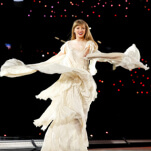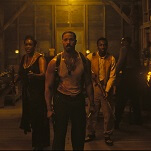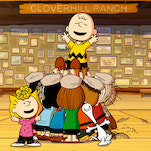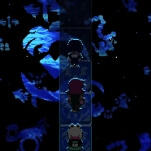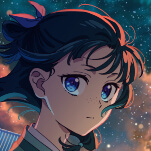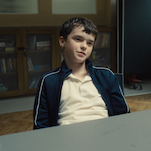(While we’re on the subject of modern video game boxart, I would be remiss if I didn’t plug Nick’s previous Art Of The Game piece covering that very subject.)
I feel like I need to automatically defend Rain World because the reviews for it have been so harsh, and it really is a great, deep game if you go into it with certain expectations. The first problem is that the game looks like it’s a Metroid-style game, but it’s not. You do not gain powers as the game moves forward, and you will not feel more powerful. Indeed, you’re probably not going to do a lot of fighting at all (though it is an option). Instead, the game is focused tightly on desperate survival and slow exploratory progress. So you find some food, you hibernate, you go out and find a bit more food and reveal a bit more of the map, then you hibernate again. Different areas of the map are gated until you’ve hibernated long enough. The game is most harsh in these gates because any “progress” you make toward them is fleeting. As soon as you die, in most case, you lose any progress you achieved. Essentially, that means that you have to survive X number of days in a row in order to get to the next area. So you need to become a master of survival in a particular area before moving on to the next.
The other hurdle in the game that has gotten a lot of negative criticism is its lack of signposts. Certain mechanics are obscure to the point of frustration. Considering the game’s fairly novel central mechanic, that seems to compound frustrations with the whole game. People go into it doing very little but repeatedly dying and seemingly losing any progress they’ve made. I believe the design decisions were clung to with the desire to facilitate the joy of discovery and the perseverance against great odds. That being said, this isn’t Dark Souls; the world is harsher and the character is much weaker. Your character is always scrounging and escaping. Additionally, it’s important to note that obstacles are not fixed, but not in a roguelike way. All of the fauna are free to roam about completely independent of your character or their previous starting points. So you might come out of a hibernation chamber into a mass of lizards fighting with each other and in the mood for an easy slugcat meal. It’s a unique experience, and I think some people might really enjoy it if they give it a chance.
Recession Proof
Earlier this week, Patrick Lee stopped by with a For Our Consideration discussing a recent wave of games that tap into the anxiety and looming terrors facing a lot of today’s young adults. The antagonists they’re pitted against, he argued, aren’t characters that can be confronted and overcome; they’re unstoppable, faceless forces “lashing out at the heroes’ youth and vitality.” A lot of those themes are caught up in hot-button political issues, like the economic crises facing certain segments of America. Merve extrapolated on that thread:
It’s worth noting that some of these games deal explicitly with economic hardship. In Life Is Strange, some of the residents of Arcadia Bay are struggling financially. In Night In the Woods, Mae’s family is having money troubles, and Possum Springs has been hit hard by the economic downturn and the hollowing out of the manufacturing sector.
These ideas have also made their way into recent bigger games, like Persona 5, as Kirino Sucks mentioned. In that game, Toranosuke Yoshida orates about income inequality and how the youth have been robbed of their future; he’s essentially a Japanese Bernie Sanders. These games certainly reflect the time in which they were made, which makes me wonder how they’ll be viewed 20 years down the line. My fear is that we won’t have made strides toward solving issues such as income inequality and the obsolescence of human labor, and these games will be just as relevant then as they are now.
Unexpected Dave had some ideas about how Persona is uniquely positioned to present an exploration of poverty’s effect on kids and teens:
I’d love to see a harder look at child and youth poverty in something like the next Persona game. In P5, the protagonist goes to a fancy school with a trip to Hawaii, he can afford to eat out whenever he wants, etc.
Imagine a Persona game starring a teenager whose guardians can’t even feed him a decent meal every day. Part of managing your character’s time would include keeping his nutrition levels high and his exhaustion level low. Limit dungeon loot to dungeon items and dungeon-only currency, and make the only source of out-of-dungeon money be your part-time job (with a schedule you can’t always control, rather than the “show up when you feel like it” arrangement that P5‘s jobs have). It would take a little tinkering to make this fun rather than tedious, but it could make for a very powerful game.
Wolfman Jew dug into this whole trend a little deeper:
We’re seeing a budding new strain of games about disempowered youths, and it’s worth staking out its focuses: teenage or child protagonists, a terrifying and probably quirky world which either passively or actively wishes them harm, stark visual styles, gameplay based around embodying that sense of powerlessness, and a partially, but never primarily, cynical worldview. These games struggle to present their ideas outside of dialogue but can be deeply powerful and satisfying when that happens. That itself speaks to something important, that these are games born out of narrative and thematic ideas, if not first, than at least early on in development.
And I think this kind of interrogation of the world’s increasingly overt bleakness makes sense to come from games, insofar as I’ve noticed it more from this medium than others. It’s treated pretty consistently as a young person’s medium, as bereft of value, and something that can’t be used to present serious ideas. Where else would these ideas of often righteous angst be expressed but within a system they understand more intimately? It’s not just that these games can use interactivity to get ideas across or that development tools are easier to acquire and use than ever before; it’s a marriage of two separate identities that are caught in a similar position of being simultaneously fetishized and demonized in unique ways. This is possibly the centerpiece of this larger shift, and it’s worth keeping it in mind for the foreseeable future.
That’ll do it for this week, friends. As always, thank you for reading and commenting. We’ll see you next week!


